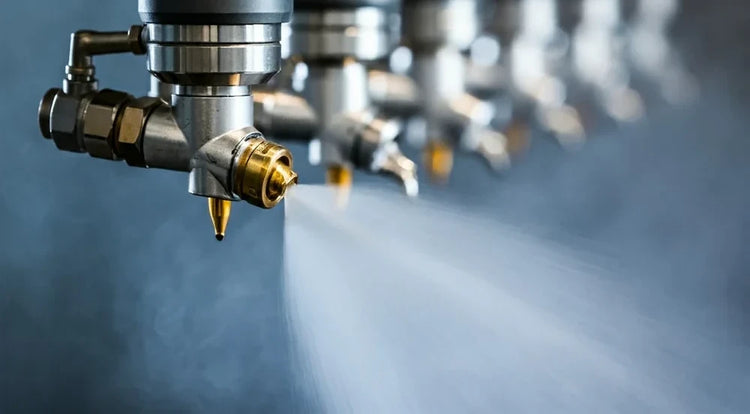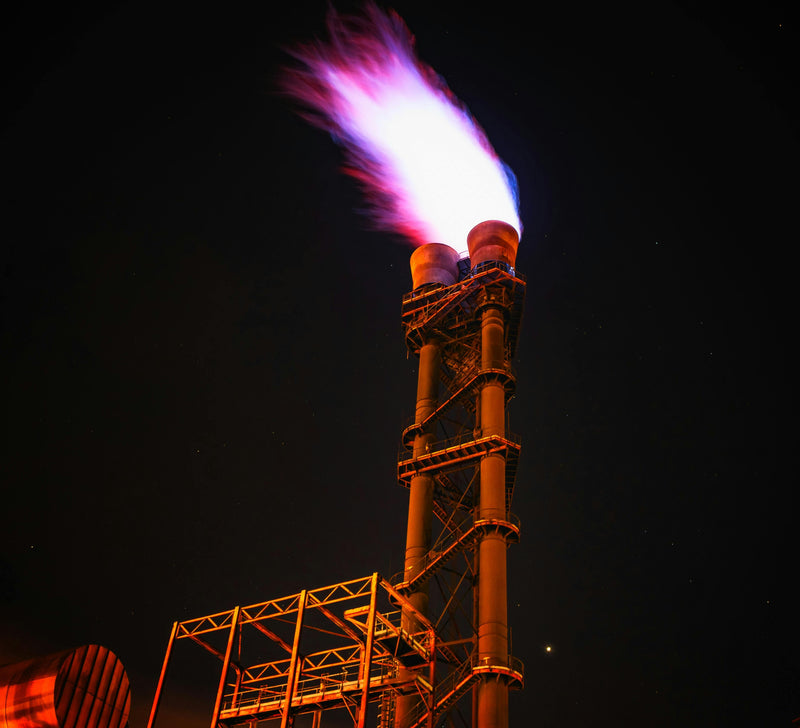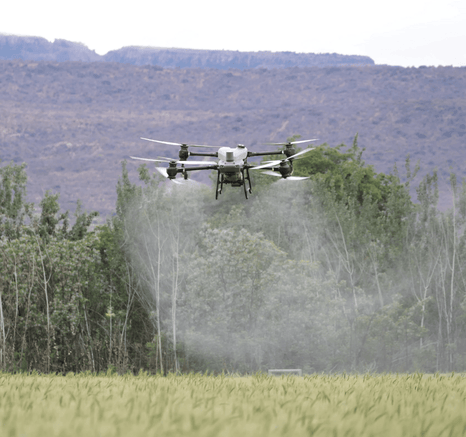Getting industrial processes to run smoothly often means picking the right tools. When it comes to spraying liquids, one tool that really stands out is the hollow cone nozzle. It's not just about spraying; it's about doing it in a way that saves money, works well, and gets the job done right. We'll look at how these nozzles work and why they're so good for many industrial tasks. We'll also see how they compare to other types and what to think about when you're choosing one for your own needs. The goal here is to help you understand how a hollow cone nozzle can make a big difference in your operations.
Key Takeaways
- Hollow cone nozzles make a spray pattern that's like a ring, with liquid mostly on the outside. This helps with things like cooling and humidifying because it creates very small droplets.
- These nozzles are good for saving energy because they often work well at lower pressures compared to other types.
- You can use hollow cone nozzles for many different jobs, like adding moisture to the air, cooling down gases, or putting thin layers of liquid on surfaces.
- Compared to full cone nozzles, hollow cone nozzles usually have smaller droplets and are less likely to get clogged up.
- Picking the right hollow cone nozzle means thinking about what you need it to do, where it will be used, and maybe even talking to people who know a lot about nozzles.
Understanding the Hollow Cone Nozzle
Hollow cone nozzles are pretty interesting pieces of equipment. They're not just about spraying liquid; it's about doing it in a very specific way. Let's break down what makes them tick.
Defining the Hollow Cone Spray Pattern
So, what exactly is a hollow cone spray pattern? Imagine a donut. That's basically what we're talking about. Instead of a solid cone of liquid, the spray is concentrated in a ring, leaving the center relatively empty. This pattern is super useful for certain applications where you need even coverage on a surface without drenching it.
Mechanism of Hollow Cone Formation
How do these nozzles create that signature donut shape? It's all about the internal design. Usually, you'll find angled or spiral channels inside the nozzle. As the liquid is forced through these channels, it starts to spin really fast. This spinning motion creates centrifugal force, which throws the liquid outwards, forming the hollow cone. Air gets sucked into the middle, which helps maintain that distinct shape.
Energy Efficiency of Hollow Cone Nozzles
One of the cool things about hollow cone nozzles is that they can be pretty energy efficient. Because of their design, they often operate at lower pressures compared to other types of nozzles, like full cone nozzles. This means you can achieve the spray pattern you need without using as much energy, which can save you money in the long run.
Using less energy is always a good thing, especially when you're running industrial processes. Hollow cone nozzles can help reduce your energy footprint while still getting the job done effectively.
Key Applications of Hollow Cone Nozzles
Hollow cone nozzles are pretty useful in a bunch of industrial processes. Their ability to atomize liquids really well makes them a go-to choice for applications where you need a fine spray and good coverage. Let's look at some specific examples.
Optimizing Humidification and Moistening
When it comes to keeping things humid or moist, hollow cone nozzles are great. They produce a fine mist that evaporates quickly, which is perfect for controlling humidity levels in greenhouses, storage facilities, and even textile mills.
- They help maintain consistent moisture levels.
- They prevent products from drying out or becoming damaged.
- They can be used to cool environments through evaporative cooling.
Enhancing Gas Conditioning and Cooling
Hollow cone nozzles are also used for gas conditioning and cooling. They spray water into a gas stream, which helps to cool the gas and remove pollutants. This is important in power plants, chemical processing, and other industries where gas emissions need to be controlled. Using the right gas cooling setup is important.
- They reduce the temperature of exhaust gases.
- They remove dust and other particles from the gas.
- They neutralize acidic gases.
Effective Thin Film Application
Another key application is applying thin films. Because hollow cone nozzles create a uniform spray pattern, they're ideal for coating surfaces with a thin layer of liquid. This is used in industries like pharmaceuticals, electronics, and agriculture. The atomization is key here.
Think about coating tablets with a protective layer or spraying pesticides evenly over crops. Hollow cone nozzles make it possible to do this efficiently and effectively.
- They ensure even coating thickness.
- They minimize waste of coating material.
- They improve the quality and consistency of the final product.
Comparing Hollow Cone and Full Cone Nozzles
It's important to understand the differences between hollow cone and full cone nozzles to make the best choice for your application. Both have their strengths, and knowing those strengths will help you optimize your processes. Let's break down the key differences.
Spray Distribution Characteristics
Full cone nozzles are known for their even spray distribution across a circular area. This makes them ideal for applications where uniform coverage is essential. They deliver liquid evenly throughout the entire cone pattern. Hollow cone nozzles, on the other hand, concentrate the liquid on the outer edge of the spray pattern, creating a hollow center. This is useful for applications needing a fine mist or where the center of the spray doesn't need direct contact. The spray pattern is a key differentiator.
Droplet Size and Atomization
Hollow cone nozzles typically produce much finer droplets than full cone nozzles. This is because of the way the liquid is forced through the nozzle, creating a swirling action that atomizes the fluid into small particles. Full cone nozzles generally produce larger droplets, which are better for applications requiring impact or surface coverage. The finer atomization of hollow cone nozzles makes them well-suited for applications like humidification or spray cooling. Here's a quick comparison:
- Hollow Cone: Finer droplets, excellent atomization, good for cooling and humidifying.
- Full Cone: Larger droplets, good surface adhesion, suitable for washing and coating.
- Droplet size impacts coverage and penetration.
Resistance to Clogging and Debris
Full cone nozzles are generally more resistant to clogging than hollow cone nozzles. This is because the orifice in a full cone nozzle is typically larger and less complex than in a hollow cone nozzle. Hollow cone nozzles, with their intricate internal designs to create the swirling spray pattern, can be more susceptible to blockage from debris in the fluid. If you're working with fluids that contain particulate matter, a full cone nozzle might be a better choice. However, some hollow cone designs are specifically engineered to minimize clogging. It really depends on the specific nozzle design and the nature of the fluid being sprayed.
Choosing between a hollow cone and full cone nozzle depends on the exact requirements of your application. Consider the desired spray pattern, droplet size, and the potential for clogging to make the best decision.
Advantages of Hollow Cone Nozzles in Industrial Settings
Hollow cone nozzles offer a range of benefits that make them a solid choice for many industrial applications. They're not always the best option, but in the right situation, they can really shine. Let's take a look at some of the key advantages.
Cost-Effectiveness and Maintenance
One of the big pluses of hollow cone nozzles is their cost-effectiveness. Generally, these nozzles have a simpler design compared to some other types, like full cone nozzles. This simpler design often translates to lower manufacturing costs, which means you'll likely pay less upfront. Plus, because they're less complex, there's usually less that can go wrong. This can lead to reduced maintenance and downtime, saving you money in the long run. Inexpensive components keep replacement costs low. More complex full cone internals generally make them costlier to produce.
Versatility Across Various Processes
Hollow cone nozzles are surprisingly versatile. You'll find them used in a wide array of industries and processes. From humidification and cooling to applying coatings and even fire suppression systems, their ability to create a fine, evenly distributed spray makes them adaptable to different needs. The superb liquid atomization from hollow cone nozzles make them an ideal choice for processes requiring humidification, oil burners, gas conditioning, moistening, mist cooling, and applying thin films.
Improved Process Efficiency
Hollow cone nozzles can significantly improve process efficiency in several ways. Their spray pattern and atomization characteristics contribute to better coverage and more effective use of liquids. This can lead to faster cooling, more uniform coating, or more efficient gas scrubbing, depending on the application. Ultimately, this translates to increased throughput, reduced waste, and better overall performance.
Using hollow cone nozzles can really optimize your processes. They are great for gas cooling processes. There are three types of hollow-cone nozzles - axial, tangential and spiral nozzles.
Here's a quick look at how hollow cone nozzles stack up in different areas:
|
Feature |
Benefit |
|
Fine Atomization |
Efficient cooling, improved coating quality |
|
Even Distribution |
Uniform coverage, reduced waste |
|
Lower Flow Rates |
Reduced liquid consumption, cost savings |
|
Wide Spray Angles |
Extended spray reach, suitable for spray chambers and tower scrubbers |
Types of Hollow Cone Nozzles
Hollow cone nozzles come in a few different flavors, each with its own way of creating that signature spray pattern. The type you choose really depends on what you need the nozzle to do. Let's break down the main types.
Axial Hollow Cone Nozzles
Axial hollow cone nozzles are designed so the liquid enters and exits on the same axis. This straight-through design helps keep things compact and simple. Inside, there's usually a disc or vane that forces the liquid to spin. As the liquid is pushed through the nozzle's opening, the spinning motion and centrifugal force create the hollow cone spray. These nozzles tend to produce smaller droplets compared to some other types, and they often have a relatively large opening, which helps prevent clogging. This makes them a solid choice when you need a fine spray and want to minimize the risk of blockages. You can always reach out to us at NozzlePro for more information.
Tangential Hollow Cone Nozzles
With tangential hollow cone nozzles, the liquid enters at a 90-degree angle to the exit. The internal design makes the liquid swirl around inside the nozzle body. This swirling action is what forms the hollow cone spray as the liquid leaves the nozzle. These nozzles are often used when a wide spray angle is needed. Because of their design, they can handle fluids with some solids in them a bit better than some other types. They're a good option when you need a robust spray in demanding conditions. The spray pattern is key.
Spiral Hollow Cone Nozzles
Spiral hollow cone nozzles use a spiral-shaped element to create the spray. As the liquid moves along the spiral, it shears off, forming a cone-shaped spray. These nozzles are known for producing a spray with a mix of droplet sizes, from a fine mist to larger droplets. The spray is concentrated on the outer edge of the cone. This type of nozzle is often chosen when you need good surface adhesion along with some impact from the larger droplets. They're also pretty good at resisting clogging, which is always a plus. If you are looking for gas cooling processes, this might be the nozzle for you.
Choosing the right hollow cone nozzle depends on your specific application. Consider factors like the required spray angle, droplet size, and the fluid you're spraying. Each type has its strengths, so understanding these differences is key to optimizing your process.
Selecting the Right Hollow Cone Nozzle
Okay, so you're thinking about using hollow cone nozzles. Great! But picking the right one can feel like a maze. It's not just about grabbing any nozzle off the shelf; it's about matching the nozzle to what you're actually trying to achieve. Let's break down how to make the best choice.
Matching Nozzle Attributes to Process Goals
First things first: what are you trying to do? The goal of your spraying process dictates the nozzle characteristics you need. Are you trying to cool something down, humidify a space, or apply a thin coating? Each of these requires different spray patterns, droplet sizes, and flow rates. For example:
- For gas cooling, you'll want fine atomization to maximize evaporation.
- For applying coatings, you might need a specific spray angle to ensure even coverage.
- For humidification, droplet size is important to avoid wetting surfaces.
Think about the ideal spray characteristics for your process, and then look for nozzles that deliver those characteristics. It's like finding the right tool for a job – a screwdriver won't work if you need a hammer.
Considering Operational Needs and Environment
It's not just about the spray itself; it's also about where the nozzle is operating. Is it in a high-temperature environment? Is it likely to get clogged with debris? These factors will influence your nozzle selection. For instance:
- If you're dealing with high temperatures, you'll need a nozzle made from a heat-resistant material.
- If clogging is a concern, look for nozzles with larger orifices or self-cleaning designs. Hollow cone nozzles are generally more resistant to debris buildup than full cone nozzles.
- Consider the available pressure. Some nozzles require higher pressures to operate effectively.
Don't forget about maintenance. How easy is it to clean or replace the nozzle? A nozzle that's difficult to maintain can lead to downtime and increased costs.
Consulting with Nozzle Experts
Still feeling lost? That's okay! Sometimes, the best thing to do is talk to someone who knows their stuff. Reputable nozzle vendors, like us here at spray.com, have years of experience and can guide you toward the right choice. They can ask the right questions, assess your needs, and recommend a nozzle that's perfectly suited to your application. Don't be afraid to reach out and ask for help. It could save you a lot of time and money in the long run.
Wrapping Things Up
So, we've gone over a lot about these two nozzle types. Just to quickly sum it up, full cone nozzles are great when you need to cover a big area and hit surfaces with some force. Think cleaning or coating. But if you're looking for really fine droplets and good reach, like for humidifying or cooling gases, hollow cone nozzles are the way to go. Picking the right nozzle really makes a difference in how well your process works. I hope breaking down these two common designs helps you make better choices for your spraying needs. Got anything else to add about full cone versus hollow cone nozzles? Let us know in the comments!












